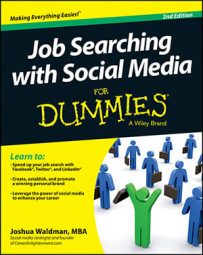Your value statement is what you tell people about yourself while job searching. Some people also call this the elevator pitch because you should be able to deliver it in about 30 seconds, or the amount of time it usually takes to ride an elevator.
You should use the same value statement when you write about yourself online as you do when you meet someone in person. Providing the same information to contacts you meet through social networking and traditional networking allows you to maintain a consistent message, and that’s really the heart of a strong personal brand.
The important thing to remember is that your value statement should help you establish instant credibility, curiosity, and likeability. Keep in mind that your value statement will change over time as well. For example, it’ll change the more you use it at live networking events, and it’ll change after you receive some feedback on your LinkedIn profile.
Many methods are out there for writing value statements. Here are three methods to choose from if you’re getting stuck or looking for inspiration. These three methods are the fastest way to help you find words around your personal brand. Pick any of the following methods for writing your value statement.
The Joel Elad method
Joel Elad offers a three-part model for crafting a profile summary on LinkedIn that’s really applicable to creating a solid value statement and not limited to any one social media site.
Elad’s method maintains a who, what, and goals format. The first sentence answers the question of your current situation (who you are). The middle few sentences answer the question of what you’ve accomplished in your professional life. And finally, the last sentence describes your goals, or what you’re going for right now.
Here’s an example of a value statement using Joel Elad’s method:
“I’m a project manager with experience in a wide variety of applications. I’ve run on-time and on-budget projects for both software deployments at XYZ Company and hardware installations for ABC Company. I’m excited about working for another insurance company that’s looking for a dedicated and self-motivated PM.”
The Jim Nudelman method
Jim Nudelman is an experienced sales trainer and a nationally known professional speaker based out of Portland, Oregon. He knows a thing or two about capitalizing on that brief window of opportunity when you make a first impression. Here’s his four-step process for crafting a value statement:
Begin with an action-plan statement that describes what you do and not just your job title.
Add a one-sentence statement about what it is you do.
Give a statement of specific impact of your service, some kind of accomplishment.
End with a call to action.
Here’s an example of this value statement in action:
“I am an Internet marketing wizard. I show job seekers how to trick the economy into giving them jobs by showing them how to use social media in the right way. People who use my five-step process or who attend my workshops tell me that they cut their job search in half and even get unsolicited offers.”
“Please let any job seekers in your life know about me and have them sign up for my blog and newsletter.”
The corporate layoff method
This method is recommended by outplacement services through a large international HR firm. You can use this method for crafting positioning statements, or value statements. Here’s the method:
Specify your desired job title.
Begin by simply mentioning what you want to do at your next job, but do it in the present tense, such as “I am a project manager…”
Select an area of focus.
Every job title has its particular compelling focus areas. For example, an IT manager may have a focus on developing technology solutions for business problems, or a marketing manager may focus on developing high ROI campaigns in the CPG space. What is your area of expertise in the field?
Give your statement some context.
No man is an island. In what professional environments were you the most successful? Did you really excel at a Fortune 500 company or was it the smaller startup that felt the most impact from your skills? Perhaps you found great joy in managing others rather than doing the task directly?
Identify what makes you unique.
Approximately 118 people compete for the same job, so you have lots of competition. What makes you different from the other job seekers out there? This difference may be technical knowledge or simply an approach to problem solving that has served you well.
Here’s an example of the corporate layoff method in action:
“I am a level 3 account manager with a focus on selling complicated business software solutions to large enterprises. I have been particularly successful in mapping large businesses’ needs with Enterprise Resource Planning software solutions that I was responsible for selling.”
“Not only were my customers extremely satisfied with their solution, but also my vice president couldn’t have been happier when I came in 150 percent over goal for three years in a row. my customers have told me that they felt I really listened to them and that’s why they trusted me with their projects.”

